yeovil people
John White Hancock
Watchmaker, Clockmaker, Silversmith & Jeweller (and Grocer & Druggist)
 John
White Hancock
was born in
Somerset about
1761. Records
for him are
quite scarce but
he is known to
have had two
sons, John Jnr
and
James, who
also became
clockmakers and
silversmiths,
two sons Walter
and George who
became
solicitors, and
two daughters, Sarah
and Mary.
John
White Hancock
was born in
Somerset about
1761. Records
for him are
quite scarce but
he is known to
have had two
sons, John Jnr
and
James, who
also became
clockmakers and
silversmiths,
two sons Walter
and George who
became
solicitors, and
two daughters, Sarah
and Mary.
John was a clockmaker, silversmith and jeweller of Middle Street and an example of his clock-making skills is shown at left and below. This particular clock has been dated to between 1828 and 1836.
He was active in Yeovil certainly from 1788 when his shop was robbed of a considerable amount of silver articles - see Gallery.
In 1790 he took out insurance on 24 June, describing himself as a "Grocer, Druggist & Watchmaker". The details of the insurance policy included £50 on furniture "in his now dwelling house, stone built and slated situate in Yeovil", £50 on utensils and trade as a watchmaker and £100 on utensils and trade as a grocer/druggist. According to Moore in the Clockmakers of Somerset, these figures indicate a fairly substantial business. £50 was a common amount to cover furniture but £150 is about three times the customary amount for the stock and utensils of a one man shop. He was a prosperous town tradesman and the number of surviving clocks suggest he was a prolific maker. The insurance was, perhaps, prompted by the robbery of his shop two years earlier.
From 1788 the Accounts of St John's Churchwardens record him almost annually until 1816 for maintaining the clock and chimes of St John's clock. Between 1805 and 1812 he was paid £2 12s 6d a year. From 1822 until 1827 the Churchwarden's Accounts record his son, John Hancock Jnr (he is actually listed as such in the Accounts) taking over the church clock and chimes maintenance and from 1837 until 1853 his other son, James, took over the clock and chimes maintenance.
In its edition of 10 February 1791 the Bath Chronicle recorded "Wednesday last Mr Hancock, watch-maker of Yeovil, was attacked on Hendford Hill, near that town, by two footpads, who robbed him of a watch and some silver."
By 1812 John had dispensed with the grocery and druggist side of the business in order to concentrate on watch and clock making as evidenced by a new insurance policy with Royal Exchange Insurance which noted "John Hancock senior of Yeovil, Somerset, Clock / watchmaker. £70 on furniture and apparel in his dwelling house and offices adjacent stone and tiled situate in Grope Lane (today's Wine Street) and £130 "on utensils and trade."
John also worked outside of Yeovil -
The Churchwardens' Accounts for Queen Camel recorded that in 1790 he was engaged to alter the church clock for which he received £10. The agreement recorded "I John Hancock of Yeovil do hereby engage to alter ye Parish Clock of Q Camel from an eight Day Clock to a Thirty Hour Clock and to put the whole in compleat Order and Repair and to find all the Materials and Carriage and whatever other Expences may be incurred in so doing for the sum of ten Pounds And I do hereby promise to engage to finish the Alterations and Repairs of ye sd Clock within three Months of ye above Date."
The Churchwardens' Accounts for East Coker recorded that in 1781 John Boucher and John Hancock were paid for "Righting the Chimes", in 1786 five shillings was paid to "Mr John Hancock (Clockmaker) for Cleaning the Church Clock" and two shillings "For Cleaning and Righting the Chimes." in 1790 10s 6d was paid for "Mr John Hancocks Bill for cleaning the Clock and Chimes." Similar entries are to be found annually in the Churchwardens' Accounts of Martock from 1817 until 1824.
However, not all was plain sailing for John Hancock and the notice placed in the Exeter Flying Post of 27 March 1817, shown below, indicates that he spent some time in 'His Majesty's Gaol of Ilchester' as an insolvent debtor at this time, prior to appearing in the General Quarter Sessions.
John and his son James were working together, certainly by 1819 when they took out insurance with the Sun Insurance Co "John and Jas. Hancock of Yeovil in Somerset, Watchmaker, jeweller and silversmiths" £30 "on their household goods in their own dwelling house only situate as aforesaid stone and tiles" £20 for their "Wearing apparel therein" and £150 for "Stock and utensils therein". The business was clearly thriving because in 1838 a new insurance policy increased the value of "Stock and utensils" to £340.
On 25 May 1820, at the age of 35, John was initiated into the Yeovil Freemasonry Lodge of Brotherly Love, describing himself as a Silversmith of Yeovil. He was also a member of Yeovil's Vestry.
Pigot's Directories of both 1824 and 1830 record John White Hancock as a 'Watchmaker & Silversmith of the Borough'. In fact his first shop, which he lived above with his family, was in Wine Street probably on the corner with the Borough. Certainly his son James was listed as a 'Watchmaker & Silversmith of Wine Street' in Pigot's Directory of 1824 and in 1830 Pigot's Directory listed 'John Hancock & Son, Watchmakers & Silversmiths of Wine Street'. Three clock dials signed "Hancock & Son, Yeovil" are shown below.
In its edition of 7 May 1829 the Bath Chronicle recorded that "Thomas Winsor, for stealing a silver watch from J W Hancock" was transported for life.
In the Somerset Gazette Directory of 1840 there is a listing for 'John Hancock, Watchmaker & Silversmith of the Borough' while the same directory lists his sons 'John William Hancock, Silversmith & Jeweller of Hendford' (John Jnr's only trade directory entry) and 'James Hancock, Watchmaker & Silversmith of Middle Street'.
By the 1841 Census John was living over his premises in Middle Street (see photograph below) immediately next door to the Medical Hall on the corner of Middle Street and the Borough. His age was given as 80 and his children James and Sarah (aged 40 and 45 respectively - the 1841 census rounded ages to the nearest 5 years) were living with him. Also living above the shop was his 20-year old nephew William Cox (his sister Mary's son) and a domestic servant. John, James and William Cox all gave their occupations as Silversmiths.
John White Hancock died in Yeovil in 1843. He was aged 82. His business was taken over by his son James.

John White Hancock's signature against the Vestry minutes of 7 April 1832.
gallery
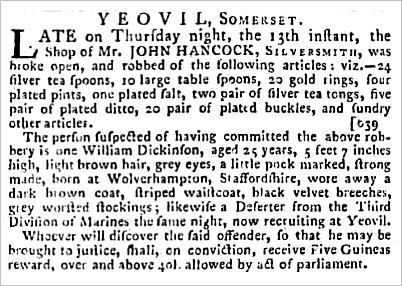
A report from the 24 March 1788 edition of the Salisbury & Winchester Journal describing the robbery from John Hancock's shop.
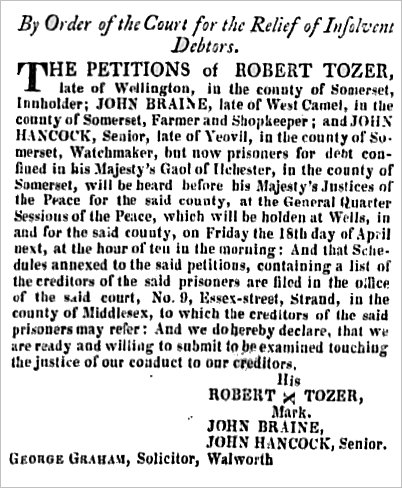
The notice placed in the 27 March 1817 edition of the Exeter Flying Post indicates that John spent some time in 'His Majesty's Gaol of Ilchester' as an insolvent debtor at this time, prior to appearing in the General Quarter Sessions.

This
colourised photograph
features in my
book 'Yeovil From Old Photographs'.
This photograph was taken by Yeovil Photographer Jarratt Beckett and published in his 1897 book "Somerset viewed through a Camera". At left is London House, at this time being run by George Wadman. At right is the side of the Medical Hall which, at this time was occupied by wholesale and retail chemists Gatward & Wright. Next door to the Medical Hall was the International Stores that had earlier been the premises of clockmaker, silversmith and jeweller John White Hancock from the 1820s, then his son James Hancock and finally Hancock, Cox & Co, Clock and Watch Makers until about 1894.
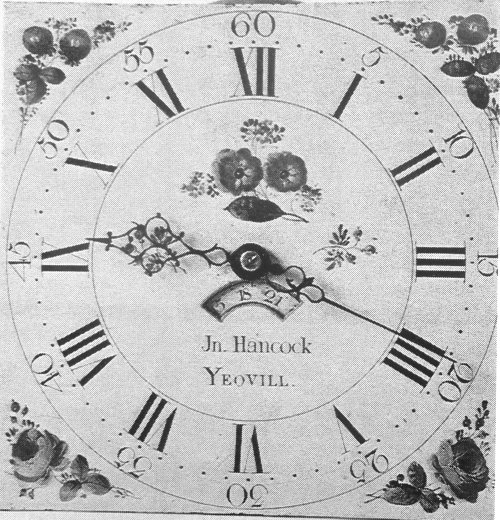
An example of a late eighteenth century clock by John Hancock. At this time his premises were in Grope Lane (today's Wine Street).
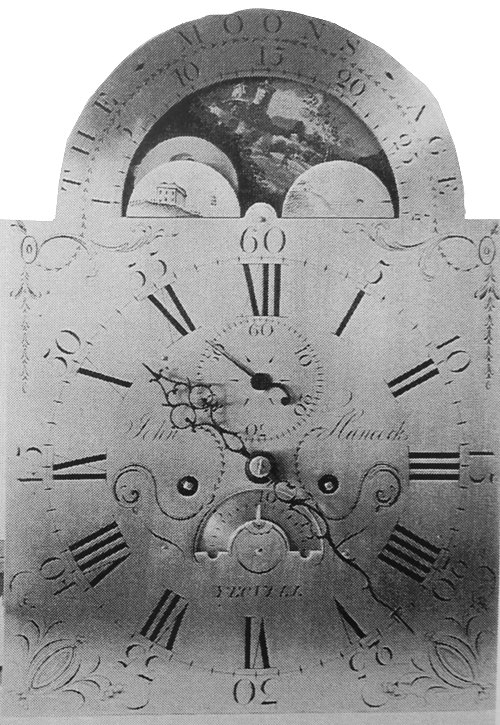
A second example of a late eighteenth century clock by John Hancock.
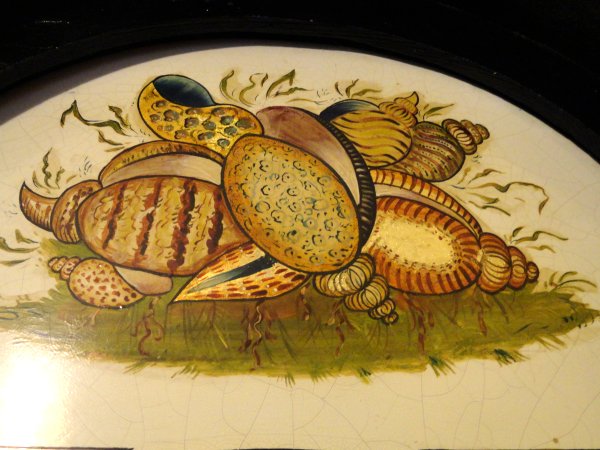
The decorative enamel panel showing seashells from the long-case clock above.
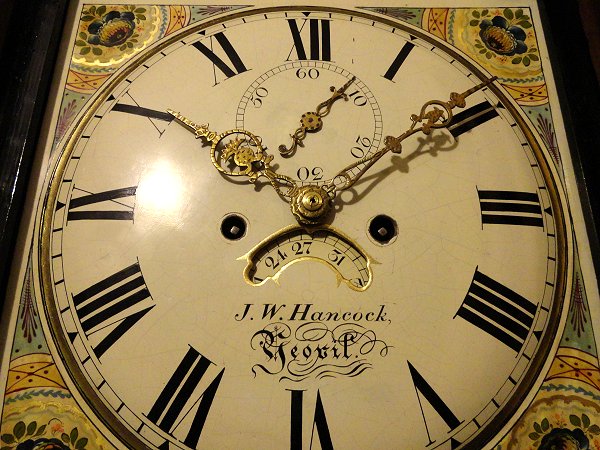
The enamelled face of the above long-case clock.
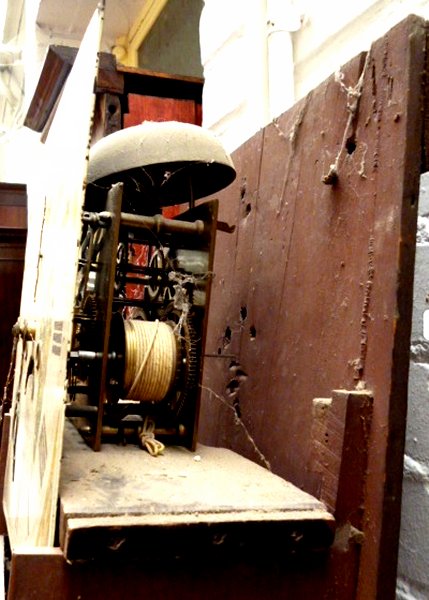
The interior of a similar clock by Hancock.

Courtesy of
Rocco Wotton
Another example of a long-case clock by John Hancock, featuring a swan motif and probably dating to about 1830.
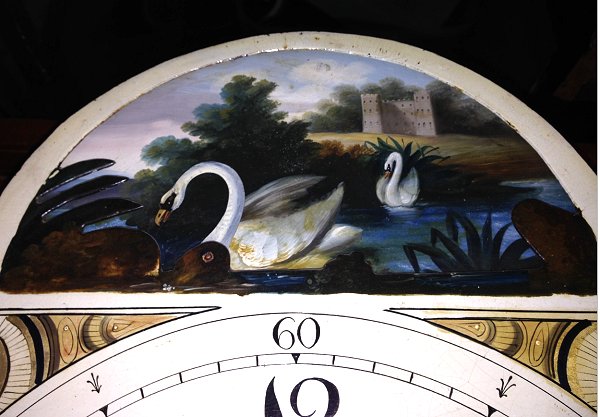
Courtesy of
Rocco Wotton
A close-up photograph of the panel above the clock face of the above long-case clock. The neck of the larger swan is pinned at its base and rocks gently in time with the clock's movement.

The first of three early nineteenth century clock dials by "Hancock & Son, Yeovil".

.... and the second example by "Hancock & Son, Yeovil".

.... and the third example by "Hancock & Son, Yeovil".
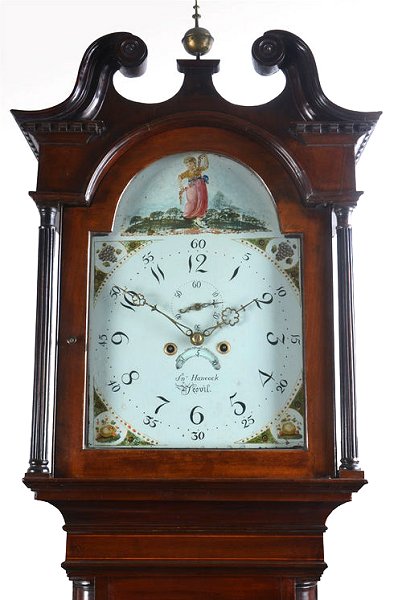
Mahogany case eight-day long case clock of about 1840, the moulded cornice with central brass finial above a frieze and glazed door flanked by free standing columns, the trunk fitted a long door, the canted base on shaped bracket feet, the painted dial signed Jn Hancock, Yeovil.

Small, plain oak long door early nineteenth century, 8-day, painted dial long-case clock by Hancock and Sons of Yeovil.
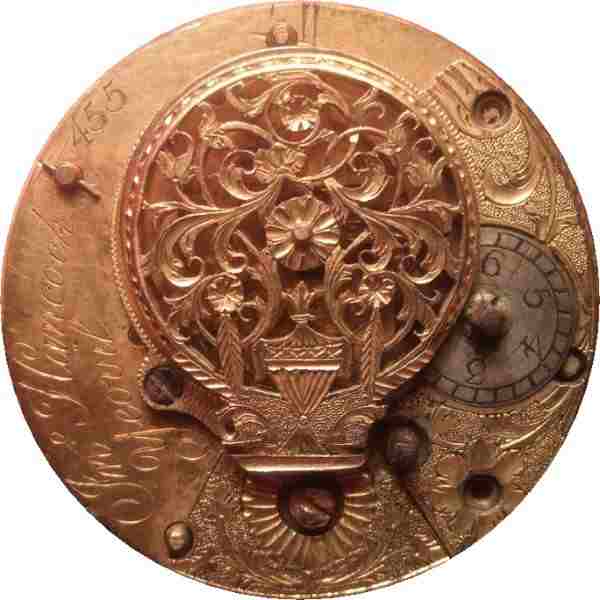
A verge fusee chain-driven pocket watch movement by John Hancock of Yeovil. It measures 40mm in diameter and is 16mm deep. Used in antique spring-powered mechanical watches and clocks, a fusee is a cone-shaped pulley with a helical groove around it, wound with a cord or chain which is attached to the mainspring barrel.